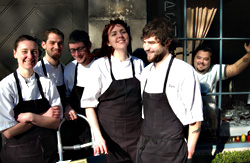Sitting over an appetizer of three lobster corn dogs ($14) at Scott Simpson’s new Fork, I finally made peace with the idea of “New American” cuisine. Biting through bubbled, crisp, cakelike corn batter into a luscious knob of buttery lobster meat impaled by a slim white stick, it came to me: Cape Cod meets Coney Island. Simpson’s having fun here, and the sweet batter all but overpowers the subtle shellfish, but the juicy, fatty lobster is a great substitute for a Nathan’s Famous. Served with house-made ketchup and stone-ground-mustard aioli, his dogs work.
You might associate Simpson, the former owner of Blue Onion Bistro in the U District, with comfort food, and that’s still an appropriate correlation. Fork’s menu borrows from classic French cuisine (steak frites with demiglace for $26) and food courts (risotto pops for $8—think jalapeño poppers, but instead truffled wild mushroom rice is panko-breaded, with remoulade for dipping) with equal verve, but the kitchen’s raison d’être isn’t to dress down confit or elevate fair food. In the 16-month lull between selling Blue Onion and opening Fork, Simpson was seduced by science. Molecular gastronomy, a movement among food scientists to put cooking methods (not cooked foods) under a microscope and dissect them, is back from the ’80s like so many bad haircuts and garish belts. So when Simpson seized the Capitol Hill space formerly occupied by the Greek restaurant Bacchus, he invested not only in white tablecloths but also in some newfangled gadgetry.
You won’t see the current food-circle buzzword “sous vide” anywhere on the menu, but the New York strip steak, served recently with sunchoke puree, braised red chard, and black trumpet jus ($21), is prepared using this spruced-up boil-in-a-bag technology. Simpson says that when you hermetically seal the meat in a pouch and cook it at a slightly lower temperature, its tough connective tissue breaks down and the result is a more tender steak. But for now, at least, he’s not calling attention to his Uncle Ben–like methodology. Fork’s kitchen also sports a device called an Antigriddle, which can cold-sear or spot-freeze just about anything. Its wonders aren’t mentioned on the menu, either. I imagine many chefs would be eager to tout their trendy chem-lab-like workrooms. Simpson, for the moment, is using the old-fashioned method of getting to his customer’s hearts: He’s going through their stomachs.
And there’s nothing subtle about his route. Fork’s current menu features pork confit (served with beluga lentils, baby carrots, and bacon for $19) and a seared duck breast entrée that the kitchen markets as “BBQ” ($22). The warm goat-cheese tart ($11) from the appetizer menu has duck confit baked into it, and even the fish dish, called “faux fish and chips” ($20), includes potatoes prepared with duck fat—though it should be noted that on an earlier visit, the dish came with duck-free fingerlings.
During my last visit to Fork, one of my companions ordered the duck breast and the other had the fish (that evening, striped bass from North Carolina). The “barbecue” was succulent, melting luxuriously in our mouths (poor girl, we made her share), the polenta even richer and creamier after it mingled with the buttery Brussels sprouts and the smoky, deeply nuanced liquid of an Asian tea sauce. As for the “faux” fish and chips: Lemon crème fraîche laced the spinach that sat between a celery-root puree, fatty potato chunks, and two seared medallions of fish. It was rather heavenly.
I chose the seven-course tasting menu that evening ($48), which began with an amuse-bouche: a dainty portion of oxtail terrine with an exceptional apple-horseradish slaw. Clearly, Simpson likes working with duck, but he seems to enjoy oxtail as well. On an earlier visit, it was featured in the evening’s special appetizer ($12): a large, oxtail-stuffed single piece of gnocchi served with braised greens. (The gnocchi was actually a little underdone; we renamed it an oxtail dumpling and didn’t finish it.)
The first full course was pink peppercorn– crusted ahi; a larger portion is offered on the regular appetizer menu for $15. Laced with sweet uni (sea urchin roe) mayonnaise, each piece of fish was topped with a tiny citrus wedge and a sliver of radish. It’s the kind of dish you want to make a meal of.
The soup, frothily whipped potato-leek, was notable for its brilliant red stripe of beet puree; otherwise, I found it bland and uninteresting.
Smeared artfully on my next plate was carrot puree, and it was anything but uninteresting. Was that ginger in the sweet orange stuff? And the onion relish! A gray gelatinous blob, but so tasty, so complex. Around these were seared scallops glazed with an almost licorcey sauce and placed atop pork-belly disks. At Fork, you will never want for fat.
Speaking of which: After a buttermilk–Key lime sorbet, I had duck confit with wilted frisée and a wonderful, hash brown–like fried potato cake. The duck, like most of Fork’s meats, comes from Sea Breeze Farm on Vashon Island. (I wish that were played up more on the menu.) Dressing this final plate was foie gras–mushroom sauce.
Dessert was disappointing: dry, seemingly day-old chocolate pound cake with Earl Gray ice cream. The latter almost saved it, but not quite. Pastry chef Amanda Spencer makes fantastic ice cream, and her flavors are highly inventive. On a previous visit, I had a trio of them that included lemon-pepper (not very peppery, but the idea was so good I didn’t mind) and peanut butter and jelly (ridiculously delicious). Simpson told me later that he’s toying with the idea of opening an ice-cream shop in the neighborhood. He figures he’ll call it Spoon.
Open since Jan. 10, Fork is doing gangbusters, and occasionally this slows down and stumbles up the service. Overall, though, Simpson has staffed his dining room with courteous, knowledgeable people—real people. His kitchen is well staffed, too. He says it runs co-op style, with him, Jared Stoneberg (previously of Rover’s), and Tyler Moritz (Union, Earth & Ocean) working as a team. (Simpson also mentioned that Moritz is a chef to watch; he predicts he’ll be the one we’re all talking about in a few years.)
Fork shows many signs of becoming the local model among New American neighborhood restaurants (Lord knows it’s not fun driving there; parking is murder), which is not to say it’s absolutely perfect. My wine-savvy friend would have really liked a Washington syrah to go with the barbecued duck, and we all noticed that the wine pours, in general, were quite small. So were our predinner martinis ($7.50), but there isn’t a bar, per se, to mingle or hang out at in this small—and some might say cramped—space, so Simpson really can’t angle for the cocktail crowd.
Most importantly, I think if Fork is to truly meld with its neighbors and become a place that Hill diners frequent on a regular basis, some of the fat—literally—could be trimmed. After all, should a person have duck confit or pork belly once a week? Or even twice a month? Maybe Simpson will open another restaurant and cut back on the lard. He could call it Knife.
Fork, 806 E. Roy St., 206-325-7400, www.forkseattle.com, CAPITOL HILL. 5–10 p.m. Tues.–Sat.; 5–9 p.m. Sun.








